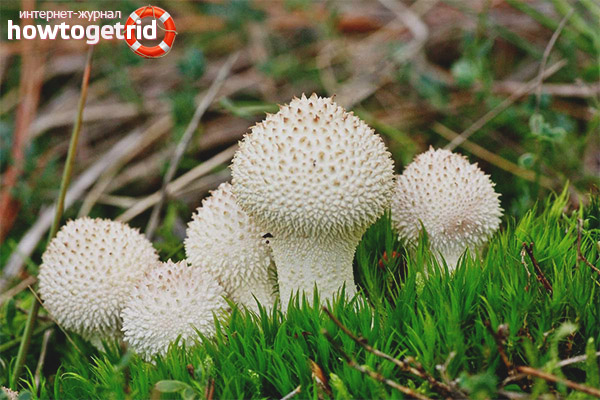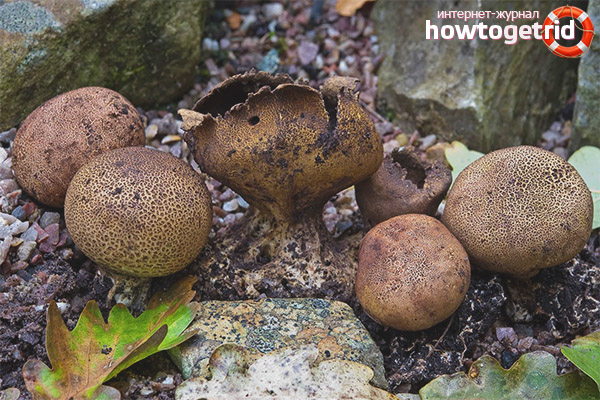The content of the article
Raincoats are unique representatives of the mushroom kingdom, both in their outlines and in their properties. For many mushroom pickers bias is characteristic of these mushrooms. They prefer not to collect them, without paying any attention to this representative. Meanwhile, they do it completely in vain. This mushroom has a pleasant taste and is good for the body. These properties are especially pronounced in young fungi. They are among the very first representatives of the mushroom set, which appears in the forest in the spring. Undoubtedly, they will brighten up the diet of any person after a annoying long winter.
Botanical Reference
These mushrooms belong to the champignon family. In shape, they resemble a pear, and white shades predominate in the color palette.These representatives can be of medium size or large (giant rain cover). Some of them have a pronounced false leg. On the head of a young mushroom there are small growths. The maturation of the dispute passes from the inside. When they reach full maturity, a hole is formed from above, through which they (spores) come out. Spores have a variety of colors, in which there are olive or brown colors.
This mushroom has many popular names. Commoners call it hare potatoes, bee sponge. There are many other names. You can often hear him called grandfather tobacco.
Types of raincoats eaten
The most common are:
- The raincoat is true.
- Golovach.
- Flashing.
Meadow, pear-shaped and pearl raincoat
These representatives fall into the 4th category. They are characterized by the highest prevalence. They are mainly found in the central and middle latitudes of our vast country. Between themselves, they have a great similarity, and pearl raincoat is suitable for food. It is covered with large spikes, which makes it a distant resemblance to a golovachom.
Golovach
Such mushrooms have more significant sizes. The height can already reach 7 cm, and the diameter is half less. There is a stronger rupture of the fruiting body after the spores mature. In all other respects, they are indistinguishable from raincoats.
Baggy golovach
The diameter of the fruit body can reach 20 cm. The shape is rounded, and at the top there is some flatness. The internal structure has a fine-grained character. The young mushroom has a light milky color. Brown shades become more saturated as the fungus grows.The fruit body of an adult fungus is cut by cracks. There are bumps that have a great similarity with warts. When the old mushroom opens, it becomes like a bowl. The mushroom has a fourth category and only young representatives are suitable for food.
Oblong golovach
It is also called marsupial golovachom. The shape of the body resembles the figures used in the bowling alley. Sometimes it is like a mace. The pedicle can be compared to half a ball. It can reach a height of 14 cm. If the weather is warm and humid, the mushroom can take on large sizes. Different sources indicate the different thickness of the upper part of the prolegs.
At a young age, the color is white, but over time it turns yellow and takes on a color with rich brown shades. Such mushrooms can be safely eaten.
Giant head
Such mushrooms are distinguished by their gigantic size. With a half-meter height, its weight can reach 20 kg. Of course, this is typical only for individual representatives. By the way, this type has the best taste. These representatives are not without flaws.First of all, they can never be seen in a group, as they grow alone. Having appeared at least once in one place, he will never grow back here again.
Poisonous representatives of false raincoats
Unfortunately, among these mushrooms there are representatives that can not be eaten. In addition, they have weak toxic properties.
Warty False Raincoat
It can not be eaten. This is a false rain coat. He is a member of the scleroderma family. They are characterized by family growth, and you can find them in the deciduous forest. Meadow plain terrain is a favorite place for their growth. Prefer to be in the tall grass. Its growth begins in the first decade of August, and ends growing only by mid-autumn. The diameter of the fruit body is from 3 to 5 cm. It has the shape of a brown tuber. Covered with an outer cork shell.
Ordinary False Raincoat
The body is in the form of a tuber with a diameter of 6 cm. The surface of the outer shell is characterized by the presence of small scales. Coloring mushroom dirty yellow. When the shell cracks, formations similar to small warts appear on it.
List of medicinal properties
For raincoats characterized by the presence of unique healing properties. They help fight hemorrhages and promote wound healing. It is necessary to attach a broken mushroom to the cut, and the blood will stop. A number of skin diseases are also treated with these mushrooms:
- severe burns;
- ulcers;
- purulent wound surface, difficult to treat;
- acne;
- hives.
With the help of such fungi fight the pathology of the upper respiratory tract and lungs:
- Bronchitis of various origins.
- Tuberculosis process.
- Laryngitis.
In the literature there is evidence that golovach prevents the formation of tumor cells. This was the reason for creating a medicine called Calvacin, for the manufacture of which is used golovach.
Where do raincoats grow?

Different representatives choose different places for their height. For example, sacking golubach from May to September can be found in open sunny glades. In most cases, it grows in single copies. In the middle of summer on the edge you can find an elongated raincoat. By the middle of October, it is already possible to meet only certain representatives of these mushrooms.At this, their growth this season ends.
Some recipes
From raincoats prepare tasty dishes.
Squash stuffed with mushrooms
For this dish is used exclusively young zucchini. Only in this case it will turn out delicious. Zucchini must be cleaned and cut into pieces to shape the rings. After that, they are boiled in water, which must be pre-salt. Ready zucchini roll in flour and fry with the addition of vegetable oil. Young mushrooms are passed through a meat grinder with onions and overcooked in a pan with vegetable oil. The finished stuffing stuffed zucchini ring.
Mushroom Noodle Casserole
Water must be salted and boil the noodles in it. The raincoats are finely chopped and fried with the addition of butter. Ready mushrooms are mixed with boiled noodles. The bottom is sprinkled with crushed breadcrumbs and the ready mass of vermicelli and mushrooms is laid out. Cooking time 20 minutes at 180 degrees.
It does not matter that these low mushrooms are assigned a low category 4. Of course, this is not a white mushroom, but it also produces simply chic dishes.The hostess should only show a creative approach to the preparation of mushroom dishes and give space for the flight of their culinary fantasy. Due to the fact that these mushrooms appear much earlier than other representatives, guests can enjoy the cooked dishes from the raincoats in the spring. There is no doubt that they will appreciate the efforts of a caring mistress.
But when collecting mushrooms, you must be extremely careful and do not confuse edible rainwear with false representatives.
Video: how to make rain












To send